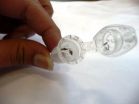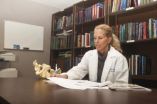(Press-News.org) New Haven, Conn.—Scientists have wondered for some time why certain seismic waves travel more quickly through the core-mantle boundary, a thin layer of the Earth's interior that lies between about 1675 and 1800 miles below the surface. Now a new study by Yale University and the University of California, Berkeley sheds light on the mystery by showing how this region behaves under the extreme conditions found so deep in the Earth. The findings, which appear in the Sept. 24 issue of the journal Science, have important implications for understanding how the Earth's internal heating and cooling processes work.
Geologists believe that most of the Earth's mantle—an almost 1800-mile-thick layer between the crust and the core that makes up more than three quarters of the planet's volume—is mostly made up of a mineral called magnesium silicate perovskite MgSiO3, or "perovskite" for short. Below this, the 125-mile-thick core-mantle boundary is composed in large part of a high-pressure phase of perovskite known as post-perovskite.
Because post-perovskite is created only under the extremely high temperatures and pressures that exist so deep in the Earth's interior, it is not found on the planet's surface. As a result, understanding the physics of this unique substance, and therefore the physics of the core-mantle boundary, has proven difficult.
Now a team led by Yale researcher Lowell Miyagi has managed to heat and compress post-perovskite to the conditions found at the core-mantle boundary, where temperatures soar to nearly 6000 degrees Fahrenheit and pressures are more than one million times the ambient pressure at the surface of the Earth.
Once Miyagi had formed the post-perovskite and squeezed it to these extreme pressures using a vise-like device that crushes substances between the tips of two diamonds, he discovered that the mineral behaved in a surprising way. "The preferred orientation of the post-perovskite's crystal structure was very counterintuitive," he said. "Post-perovskite has a layered crystal structure, but instead of deforming along the layers when compressed, like almost every other layered structure does, it deforms on a plane cutting across the layers." Knowing more about the structure of the material that makes up much of the core-mantle boundary will help scientists understand how seismic waves travel through this region of the Earth's interior.
Based on their experimental results, the team found that their model for mantle mixing correlates well with seismic observations. "The findings could explain why seismic waves tend to travel faster in certain directions near the core-mantle boundary," said Kanani Lee, assistant professor of geology and geophysics at Yale and one of the study's co-authors. "The alignment of post-perovskite's crystal structure likely determines in which direction seismic waves travel fastest in that region. Understanding this structure gives us much more insight into the extreme physics taking place 1800 miles below the surface."
It will also provide clues as to how Earth's internal convection works there. After descending from the ocean floor, cool tectonic plates pass through the mantle and approach the dense, liquid-iron outer core, where they heat up and begin moving upward again in a repeated cycle of mantle mixing.
"Understanding how post-perovskite behaves is a good start to understanding what's happening near the mantle's lower reaches," Miyagi said. "We can now begin to interpret flow patterns in this deep layer in the Earth."
INFORMATION:
Other authors of the paper include Waruntorn Kanitpanyacharoen, Pamela Kaercher and Hans-Rudolf Wenk (University of California, Berkeley).
Scientists recreate extreme conditions deep in Earth's interior
2010-09-24
ELSE PRESS RELEASES FROM THIS DATE:
Current decisions shape your future preferences
2010-09-24
Psychologists have known for a long time that after you make a choice, you adjust your opinion to think better of the thing you chose. Now a new study has found that this is true even if you don't know the options that you're choosing between.
People change their minds about a choice after they make it. If you ask someone how he feels about Athens and Paris, he might rate them the same. But after you make him choose one as a vacation destination, he'll rate that city higher. This is thought to be a way to reduce the psychological tension that is created by rejecting ...
Arctic soil study turns up surprising results
2010-09-24
Across the globe, the diversity of plant and animal species generally increases from the North and South Poles towards the Equator but surprisingly that rule isn't true for soil bacteria, according to a new study by Queen's University biology professor Paul Grogan.
"It appears that the rules determining the patterns for plant and animal diversity are different than the rules for bacteria," says Professor Grogan.
The finding is important because one of the goals in ecology is to explain patterns in the distribution of species and understand the biological and environmental ...
New technique uncovers hidden insecticide resistance
2010-09-24
A new technique pioneered at Liverpool School of Tropical Medicine (LSTM) is improving the detection and monitoring of insecticide resistance in field populations of an important malaria-carrying mosquito.
Researchers at LSTM, led by Dr Charles Wondji have developed a new technique which encourages the female Anopheles funestus mosquitoes to lay eggs which are then reared into adult mosquitoes to provide sufficient numbers to determine levels of insecticide resistance and to characterise the underlying mechanisms.
Explaining the significance, John Morgan, who designed ...
Patients with cancer who stop hospice care boost health-care costs
2010-09-24
Researchers at Mount Sinai School of Medicine have found that the costs of care for patients with cancer who disenrolled from hospice were nearly five times higher than for patients who remained with hospice. Patients who disenroll from hospice are far more likely to use emergency department care and be hospitalized. The results are published in the October 1 issue of the Journal of Clinical Oncology.
Led by Melissa D.A. Carlson, PhD, Assistant Professor of Geriatrics and Palliative Medicine, and Elizabeth H. Bradley, PhD, Professor of Public Health at Yale University, ...
Nonstick coating of a protein found in semen reduces HIV infection
2010-09-24
A non-stick coating for a substance found in semen dramatically lowers the rate of infection of immune cells by HIV a new study has found.
The new material is a potential ingredient for microbicides designed to reduce transmission of HIV, a team from the University of Rochester Medical Center and the University of California, San Diego reports in a forthcoming issue of the Journal of Biological Chemistry.
The coating clings to fibrous strings and mats of protein called SEVI–for semen-derived enhancer of viral infection–which was first discovered just three years ago. ...
Molecular 'playbook' for halting heart failure risk factor uncovered
2010-09-24
Like a well-crafted football play designed to block the opposing team's offensive drive to the end zone, the body constantly executes complex 'plays' or sequences of events to initiate, or block, different actions or functions.
Scientists at the University of Rochester Medical Center recently discovered a potential molecular playbook for blocking cardiac hypertrophy, the unwanted enlargement of the heart and a well-known precursor of heart failure. Researchers uncovered a specific molecular chain of events that leads to the inhibition of this widespread risk factor. ...
Rensselaer researchers provide insight into the impacts of too much communication
2010-09-24
Troy, N.Y. – Individuals within a networked system coordinate their activities by communicating to each other information such as their position, speed, or intention. At first glance, it seems that more of this communication will increase the harmony and efficiency of the network. However, scientists at Rensselaer Polytechnic Institute have found that this is only true if the communication and its subsequent action are immediate.
Using statistical physics and network science, the researchers were able to find something very fundamental about synchronization and coordination: ...
Study finds high rate of c-sections after pelvic fractures
2010-09-24
In research led by a Saint Louis University surgeon, investigators found that women who give birth after suffering pelvic fractures receive C-sections at more than double normal rates despite the fact that vaginal delivery after such injuries is possible. In addition, women reported lingering, yet often treatable, symptoms following their pelvic fracture injuries, from urinary complications to post-traumatic stress disorder.
The study, published in Clinical Orthopaedics and Related Research, retrospectively reviewed the cases of 71 women who had suffered pelvic fractures, ...
Caltech researchers design a new nanomesh material
2010-09-24
PASADENA, Calif.—Computers, light bulbs, and even people generate heat—energy that ends up being wasted. With a thermoelectric device, which converts heat to electricity and vice versa, you can harness that otherwise wasted energy. Thermoelectric devices are touted for use in new and efficient refrigerators, and other cooling or heating machines. But present-day designs are not efficient enough for widespread commercial use or are made from rare materials that are expensive and harmful to the environment.
Researchers at the California Institute of Technology (Caltech) ...
University of Nevada, Reno, demonstrates successful sludge-to-power research
2010-09-24
RENO, Nev. – Like the little engine that could, the University of Nevada, Reno experiment to transform wastewater sludge to electrical power is chugging along, dwarfed by the million-gallon tanks, pipes and pumps at the Truckee Meadows Water Reclamation Facility where, ultimately, the plant's electrical power could be supplied on-site by the process University researchers are developing.
"We are very pleased with the results of the demonstration testing of our research," Chuck Coronella, principle investigator for the research project and an associate professor of chemical ...





